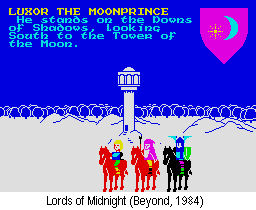|

By Lloyd Mangram
August
1984
Issue 7
|
|
Right
from the start Oliver had been illustrating CRASH with
a mixture of action-packed comic-strip pictures and
gentler, more humorous cartoons of variously-shaped
alien beings. The latter became very popular with readers,
who dubbed them 'Oli-bugs'. They can still be seen at
the top of the editorial page today. To mark the holiday
season, Oliver gave dynamic game themes a rest - and
the bugs a cover. A typical CRASH reader relaxes with
friends on the sands of some far off planet, complete
with all the luggage he needs - a monitor, joystick
and his Spectrum.
|
During July, as the August issue was being written, Newsfield
moved into its new premises in King Street - in spirit if
not in fact. Hold ups over the lease meant that we were still
crammed like sprats in a pickling jar in Roger's house where
we had started out.
Space wasn't the only concern, the need for more professional
equipment to produce the magazine's black-and-white pictures
had led to the procurement of a large, computer-operated process
camera. It was important to have it, and it had been thought
that there would be space to put it. The machine arrived in
July with no home, but the directors took the risk of installing
it in the new offices hoping that the lease problems would
be sorted out quickly. Fortunately they were, although not
in time for this edition. The camera went on the third floor
and weighed a ton; it would have been awful to have had to
carry it all the way down again!
Out in the wide world, a terrible event had taken place:
the great British software hope, Imagine, had collapsed owing
fortunes, including several thousand pounds of advertising
revenue to CRASH. At the time, it seemed to be the most visible
tip of an iceberg of financial strains for the software industry,
and directly led to the notion of the summer software Slump,
a concept that's stayed with us ever since.
 And
yet this issue provided some excellent games. The three arcade
Smashes were from Micro-something-or-others. There was Micromega's
marvellous bike road-racer, Full Throttle, Micromania's
Kosmic Kanga and Mikro-Gen's Automania. Of the
last, the review kicked off saying 'Meet a new hero . . .
Wally Week is destined for big things . . . ' It wasn't a
psychic prediction but a reference to the pay rise he hoped
to get from working hard in a car factory. Now, it's a matter
of history that Mr Week was indeed destined to become very
big. The other biggie was Beyond's Lords Of Midnight,
which had finally arrived and sent Derek into paroxysms of
delight. It set 'new high standards in Spectrum software,'
he declared. And
yet this issue provided some excellent games. The three arcade
Smashes were from Micro-something-or-others. There was Micromega's
marvellous bike road-racer, Full Throttle, Micromania's
Kosmic Kanga and Mikro-Gen's Automania. Of the
last, the review kicked off saying 'Meet a new hero . . .
Wally Week is destined for big things . . . ' It wasn't a
psychic prediction but a reference to the pay rise he hoped
to get from working hard in a car factory. Now, it's a matter
of history that Mr Week was indeed destined to become very
big. The other biggie was Beyond's Lords Of Midnight,
which had finally arrived and sent Derek into paroxysms of
delight. It set 'new high standards in Spectrum software,'
he declared.
Among those that just missed being a Smash were Ocean's Cavelon,
another Panayi 3-D game from Vortex, TLL and 3-D
Tank Duel, this last from a new software house called
Realtime, now developers of many Spectrum games for large
companies. One of the three programmers, Andrew Onions, was
originally from Ludlow. His parents lived five doors away
from Roger Kean (incidentally, the house is now rented by
Richard Eddy and some others from Newsfield). Everyone loved
Tank Duel, the best-ever implementation of that old
arcade original, Battlezone. But we were also aware
that the review could be called biased if the Ludlow connection
became recognised, so Matthew Uffindell and Chris Passey were
kept in the dark as to who Andrew Onions was!
Advertising was becoming increasingly more professional,
better images, better designs and more impact. Along with
the improvement, however, came an additional helping of hype
- classier boasting doesn't necessarily mean a classier product.
The more pre-release exposure a game received, the harder
it could fall - companies too. One such game, well advertised
and eagerly awaited, was also one of the earliest 'big' licences,
CRL's War Of The Worlds. Based on HG Wells's famous
novel and with a helping hand from Jeff Wayne's equally famous
music, the game proved only too well that a good idea and
loads of hype aren't set for success unless there's also good
game design and a decent program in there somewhere. Soon
enough, the established companies would be able to employ
the talents of individuals and teams, but in 1984 the best
of those people were struggling to make their names as independent
outfits, like Realtime.
|